Source: RAV4World
2006+ RAV4 Front Brake DIY
Some other forums I’m on (VWVortex.com, shameless plug) have really good DIY threads. Here, not so much. I’ve learned a lot from these and even if I didn’t ultimately do the job myself, there was enough detail to know it was something I didn’t want to get involved with. Brakes on most modern cars are a snap (much easier than old drum brake jobs where you had to release the shoes to get the drums off, play with a multitude of springs and repack and adjust wheel bearings as part of the job). I’d suggest doing your own to any averagely capable person. Why?
1) It saves money (Sometimes a lot)
2) You know what was done and how, using quality parts
3) Getting to know your car is good carma (Yup, misspelled) but there is a Zen to it.
I wound up with this job after a call from my wife who had her RAV in for it’s 60K physical and they reported the fronts down to 3mm. Not crucial but about time. The estimated tab? $287 to replace shoes only, no rotors no rotor cutting, no brake flush.
I said NFW, they’re robbers and rather than search out more honest folks, looked into the DIY approach.
Rotors are not absolutely needed unless they are scored or you have surging while braking etc. BUT, I’m recently indoctrinated into the VW school of brakes which teaches, replace the rotors, it isn’t that expensive and it is your life on the line. Perhaps a little harsh but replacing rotors probably saves about 3 hrs on a DIY brake job or sometimes even a day depending on how quick your local jobber will cut them (if at all, some places won’t cut rotors regardless of remaining thickness, too much liability and not worth their bother). If your rotors are really good, pads may be enough (measure the remaining thickness and compare to the shop manual or if they are scored (check w/ your fingernail), replace them, it’s about $100 and good piece of mind).
So, off to the internet for parts. There are a wide range of choices, prices, pad compounds etc. Since we don’t drive the vehicle hard and our trailers have brakes, I settled on the Akebono ultra ceramic pads (http://www.rockauto.com/catalog/moreinfo.php?pk=1144661). Reported to be better than OEM w/ less brake dust. Rotors were Centric parts (CENTRIC Part # 12044146), smooth, vented like OEM (drilled or slotted are for wanna be racers and just wear pads and make noise. You don’t need this for good or even better than OEM braking). All from Rockauto.com for <$200 shipped. I thought pretty reasonable. Parts came in 3 days and they were as ordered.
As with all auto work, work safe with safety glasses, jackstands etc. and dispose of all wastes properly.
Tools Required:
Pads Only-
3/8” ratchet
14mm, socket
17mm cone wrench (See below)
10mm flare nut, box or brake bleeder wrench
Small and medium flat head screwdriver
Small wire brush
Speedy bar clamp or medium C clamp
Another socket, 17mm or larger for clamping
Baling wire
One man bleeder bottle or very patient and reliable friend
Turkey baster and container
Silicone brake lubricant
RTV brake anti-squeal compound
Pint or more of DOT 3 brake fluid
Note- A cone wrench is a thin open end wrench commonly used on bicycles. If you don’t have one, you may need to grind down the thickness of your 17mm wrench. I bought a cheap set of metrics for bicycles that are much thinner than Craftsman, SK or Husky and they work well. Grinding down your open end wrench isn’t too big a deal since you should never use open ends where high torque is applied anyway. Just oil it so it doesn’t rust.
Rotors too-
½” breaker bar and ratchet
17mm 6 point socket
Aluminum anti-seize lubricant
Aerosol brake cleaner
On to how to do it. Break the front lug nuts loose, jack up the front end and support on jack stands, no cinder blocks or other, safety first.
Remove the wheels and inspect what you’ve got. Look for uneven wear, corrosion etc.
Pull off the small access panel over the brake filler and set aside. Remove the cap and lift out the filter screen. Don’t get brake fluid on the paint! It eats it up. Using the turkey baster, suck out as much old fluid as you can. Don’t refill yet.
If doing just pads-
Remove the rubber cover over one of the bleeders and connect the one man bleeder to the zerk (bleeder) fitting (either side is OK). Install the clamp with the large socket bearing on the outer pad on the outside and the other end of the clamp on the back of the caliper. Loosen the bleeder while applying force to the clamp until you see a decent gap between the back of the outer pad and the caliper. Otherwise if you moved an Oz or more of fluid, you are probably good. Close the bleeder fitting and remove the clamp and socket. 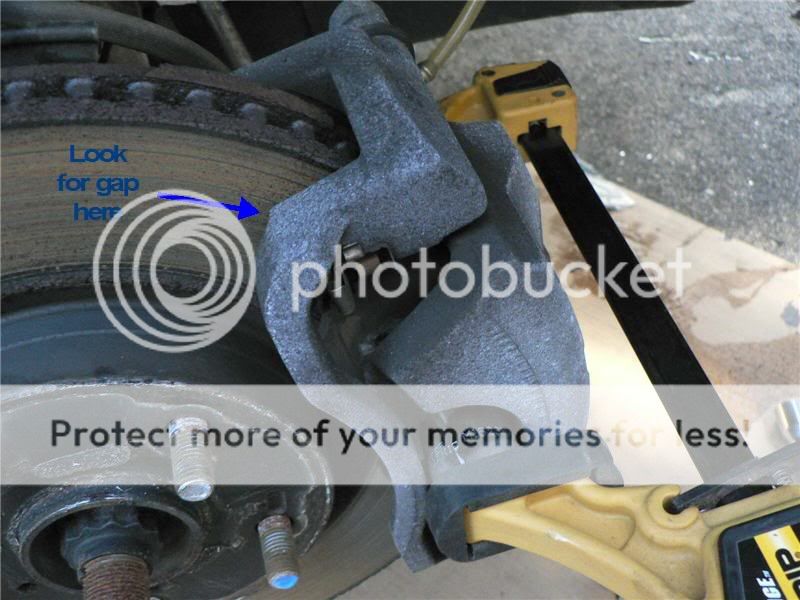
Please click image for fullsize
Remove the 14mm bolts from the caliper to carrier connection (the bolts w/ the rubber boots next to them). You may need to back wrench with the cone wrench on the nut between the carrier and the caliper but usually not. 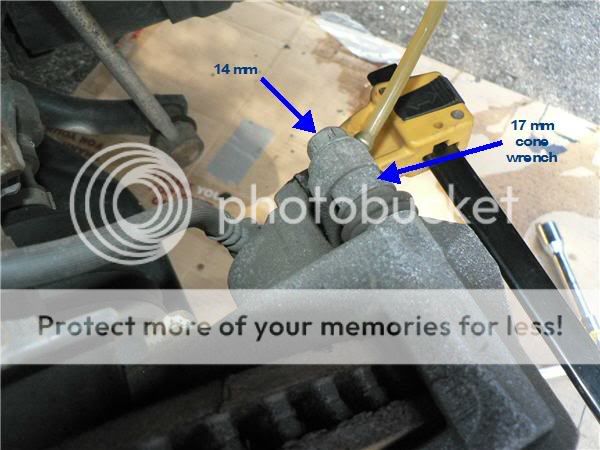
Please click image for fullsize
Once these bolts are out, get out your baling wire and you can remove the caliper from the rotor by pulling radially. Support the caliper w/ the baling wire to the strut tower so you don’t stress the brake line. Pads will be left in the carrier most likely or fall on the ground, no biggy.
If they didn’t fall out, push the used pads out out of the carrier by prying at the bottom between the pad and the rotor. Note that the clips in the carriers should remain and the clips on the pads face up. Do not discard yet. Compare old pads to the new ones you got to see that they are indeed the same! 
Please click image for fullsize
Clean up inside the caliper and piston face w/ the wire brush. Clean up the outside edge of the rotor if reusing and the outer “hat” portion.
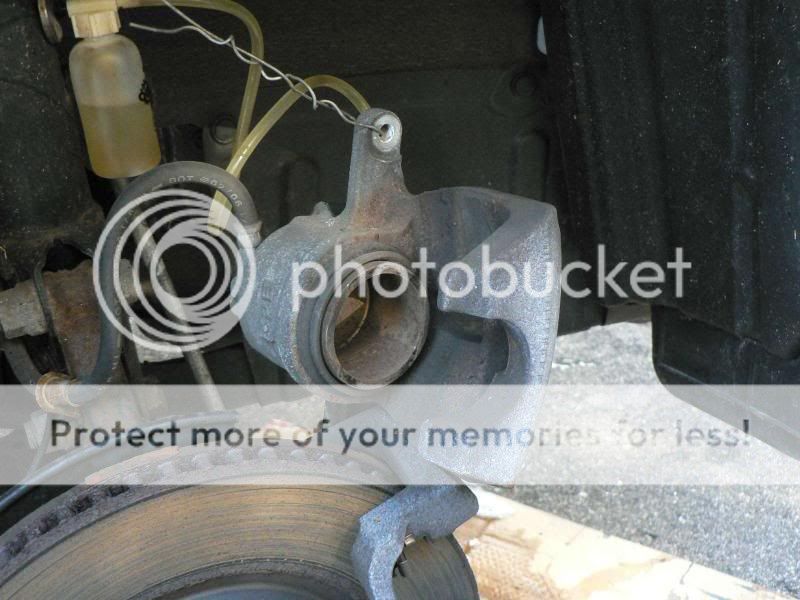
Please click image for fullsize
Turn one of the pads “inside out” and place against the brake cylinder while installing your clamp on the pad and the rear of the caliper. Snug it up very firmly.
Loosen the bleeder fitting again and watch for fluid movement. As it flows, continue to compress your clamp until the face of the cylinder is flush with the surface of the caliper. Close the bleeder valve.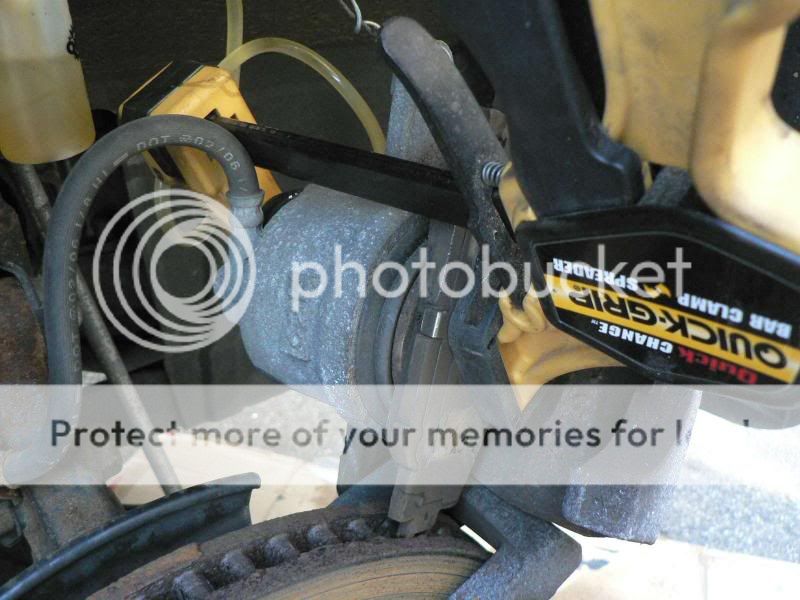
Please click image for fullsize
Remove the clips from your old pads using the small screwdriver to release the tang and reinstall on your new pads.

Please click image for fullsize
Apply the brake lubricant onto the face of the cylinder, the fixed parts of the caliper that hold the outer pads and all clip and bearing surfaces. DO NOT get any on the face of the pads. If you do, remove with brake cleaner and some medium sandpaper. Apply anti squeal to the back of the pads where they make contact w/ the cylinder and fixed parts if desired and let that set up 5-10 minutes (optional).
Rotate and slide the bolts in the carrier that have the rubber boots on them (17mm). If they are very free, OK then. If there is any binding, grit or snugness, carefully remove the boots, clean with brake cleaner (not on the boots!) and lubricate with the silicone brake lube. These are what keep your brakes wearing evenly and if they don’t move freely, neither will your brakes. Definitely disassemble and lube every other brake job and no harm in doing it every one (No pics because my hands were greasy and I didn’t want to get it on the camera!).
Install your new pads loosely into the carrier inserting the end opposite the clip (bottom) first and then rotating the top into place. They should go in easily and be held reasonably well. Do not force, if they bind, try again. Push firmly and evenly against the rotor.
Reinstall your caliper with the retracted cylinder. Install the 14mm bolts and torque per manual or judgment (Remember how tight they were? Not terribly but not loose either).
Repeat on the other side and go onto Bleed/ Flush.
If doing Rotors too-
Start as per “just pads” except don’t put the new pads in yet.
Using the breaker bar and 6 point socket, remove the 17mm carrier bolts (yes, they are very tight).
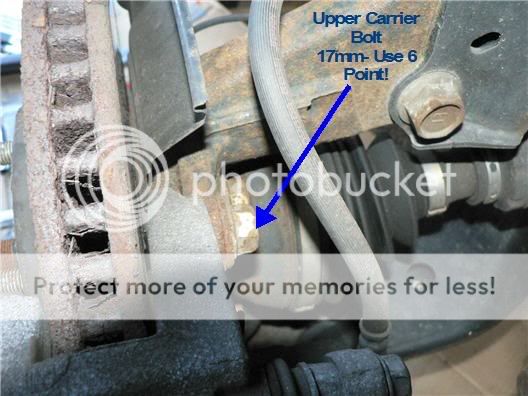
Please click image for fullsize
The rotor will just fall off or may be stuck. If stuck, give the center hub a few whacks with a dead blow hammer or just tap around the hat. Set rotors aside for future cutting if possible.
Clean the rotor faces up with brake cleaner and very clean rags. Rotors are supposed to be ready to install but there is always some residual machining oil.
Turn the rotors hat side down and paint the back side of the hat and the ID for the hub with anti seize. This prevents binding next time.
Install on the hub and reinstall the carrier using as much torque as you used to remove it or per manual.
Install pads and calipers per “Just Pads”.
Bleed/ Flush-
Brake fluid should be replaced every two years or so because it absorbs water that initiates corrosion and loses temperature capability (no boiling brakes on downhill mountain passes please). Shops will charge you serious $ for this and it’s really pretty easy to get 90%+ of the fluid replaced (Good enough). I have a pressure bleeder for my VW to avoid the assistant but don’t have the Toyota adapter (yet), so this is the old school method.
Get the baster out again and remove the fluid you might have pushed back when compressing your calipers. Top off with fresh fluid.
Go the passenger side rear brake, find the bleeder and remove the rubber cover. Install your one man bleeder (partially filled) and have an assistant at the brake pedal. Loosen the bleeder slightly and retighten. It’s tight but you don’t have to jack the rear to get to the bleeders.
Have your assistant apply steady pressure to the brake pedal (car off) and give you a yell as it is getting to the bottom. When they yell, close the bleeder. You will see the fluid going into the bleeder bottle and repeat the “push , bleed , hold” cycle until you have added about 6 Oz of brake fluid to the bottle (may need to dump the bottle in between).
Check the master cylinder and add fluid if needed (probably).
Move on to the drivers side rear and as before but bleed only 3-4 Oz of fluid.
Same but with passenger front and finish with drivers front, clearing about 3 Oz each cylinder.
Your pint should be gone, the reservoir should be full and you should have almost all of the fluid replaced sans ABS which is a small adder. If you are fussy you could run the car and do it again or get a scanner that will cycle the ABS while bleeding but that’s a really big, spendy deal. Other than the dealer, other shops probably would not do that.
Break –In-
Many brake pads claim no break in required. OK but break –in shouldn’t hurt them and you read more about lousy brake performance after brake jobs than before so I’m a believer (glazed rotors are a drag and don’t stop for crap). Here’s a good link and I use their methods.
http://www.stoptech.com/tech_info/wp_bedinstock.shtml
Conclusion-
With the Akebono pads, there was serious green fade but that seemed to stop after the first round of break in and cooling. Glad I tried to break them in. No noise, initial “bite” seems better than OEM and I like the pedal feel better (I always felt the OEM’s had no feel until heavy braking, They stopped but initial bite was weak). Have not driven these in the rain yet so can’t comment and they have not been on long enough to comment on wear or dust. No complaints from the WF and she thinks they “might be a bit better”. So far I like them and I like the $ in my pocket and seeing how easy it is. I’ll save the OEM rotors for next time, they are not grooved or warped and can certainly be cut at least once.
All in all this took me about 2 hours, including finding the camera, photos and tracking down my thin wrenches (about 15 minutes there!). Well worthwhile and probably an hour next time.
Hope this helps someone!


 Posted in
Posted in  Tags:
Tags: